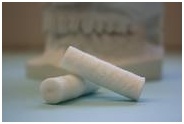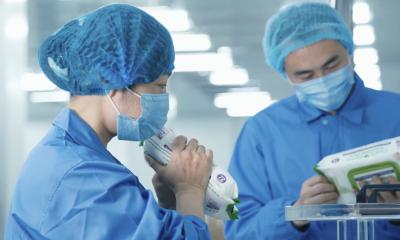Hohenstein Institute develops textile that releases medicinal gasses
The Institute for Hygiene and Biotechnology (IHB) at Hohenstein has developed the first textile that can release medically effective gasses. The textile was developed at the IHB under the auspices of a broader research project. The textile will be used in future therapeutic applications.

The prototype that has been developed consists of cotton fibres that have been refined with silicon oxide particles by using nanosol technology. Bonded into this matrix is a substance that functions as a dispenser for nitrogen monoxide (which is also known as nitric oxide). It releases the gas under physiological conditions.
The areas in which a material that emits nitric oxide could be applied are diverse because the molecules of the gas possess a wide range of characteristics. Nitric oxide is naturally present in the human body, where it serves a number of biological purposes, including, e.g., for vasodilatation and as a molecular neurotransmitter. In addition, nitric oxide also has an anti-bacterial effect based on destruction of the cell membranes of bacteria, damage to their genetic material and restriction of their metabolism for energy.
One decisive factor in ensuring nitric oxide's effect is guaranteeing it is released close to the site of application, because the molecule itself has a very short half-life. As a result, scientists at the Hohenstein Institute used nitric oxide coating techniques primarily in the development of anti-bacterial textiles for use in dentistry. Publications of other working groups, however, suggest that coatings that release nitric oxide could also be used for implants such as catheters, prostheses, or in vivo sensors, where they could prevent the adhesion of bacteria.
In addition to demonstrating the release of nitric oxide from the textile, the scientists at the IHB have also proven the anti-microbial efficacy of the gas releasing textile material with the help of the DIN EN ISO 20743 standard and developed a system for measuring nitric oxide in the physiological environment of the mouth. Detailed results are expected to be published end 2010 when the research project "Nitric Oxide Releasing Dental Cotton Rolls with Anti-microbial Effect" (AiF-Nr. 15721 N) will be completed.
The research project AiF-Nr. 15721 N of the registered association Forschungskuratorium Textil e.V. is financed as part of the programme to promote Industrial Community Research (IGF) of the German Ministry for Economy and Technology (BMWi) through the "Otto-von-Guericke" German Federation of Industrial Research Associations (AiF).
05.06.2009





